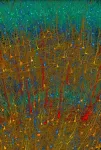(Press-News.org) In urban areas throughout the United States, it is imperative for all communities to have equal access to high quality parks. These parks can have many benefits for the physical and mental well-being of the residents who live in close proximity to the urban green spaces. For instance, they are a place to socialize and exercise outdoors while also providing vegetation nearby, which can help reduce urban heat.
Yet, in the City of Philadelphia, not all parks are created equal, according to a new study from the University of Delaware.
Using a machine learning algorithm to analyze 285 parks from over 100,000 park reviews gathered from Google Maps, the study shows that a majority of the parks that are considered to be of high quality are located in areas that tend to have more affluent, white and college educated residents. The parks that scored the lowest tend to be in areas where the residents are historically marginalized: mostly low-income, Black and Hispanic, with a lower educational attainment.
The researchers corroborated the reviews with the physical characteristics of those parks using satellite and aerial imagery, as well as data from police reports and the Philadelphia Parks and Recreation Department.
The study was published in Scientific Reports and was led by Matthew Walter, a doctoral student in the Department of Geography and Spatial Sciences, which is part of the College of Earth, Ocean and Environment. This paper is the first part of Walter’s dissertation, in which he will continue to look at green spaces outside of parks in urban areas.
The co-authors include UD’s Pinki Mondal and Benjamin Bagozzi. Mondal is an assistant professor in the Department of Geography and Spatial Sciences who also holds a joint appointment with the Department of Plant and Soil Sciences and is a resident faculty member at the UD Data Science Institute. Bagozzi is an associate professor in the Department of Political Science and International Relations and assistant director of the Master of Science in Data Science program. Idowu Ajibade, associate professor in the Department of Environmental Sciences at Emory University, was also a co-author on the paper.
Social media shows social injustice
Walter said that by looking at social media reviews of parks from 2011 to 2022, and by looking at a large amount of reviews spread across a wide range of parks, the researchers were able to see how a large population of the City of Philadelphia was feeling about its urban parks.
Because people can put whatever they want into the reviews, which also come with a one-to-five-star rating system, the data they collected is known as unstructured data.
“In order to see what people were saying about these parks and to see why people are giving it higher scores or lower scores, we used a technique called Natural Language Processing, which is using machine learning to extract information out of a large set of information,” Walter said. “That’s how we condensed the text-based part of the review into a few different categories or topics. We could see which keywords are most likely to be mentioned and we did that by using anchor words where you can steer the model towards different groupings using those anchor words.”
The researchers used eight different topics, and for each one they used 10 different anchor words to set the topic up. For example, if they wanted to look at a park’s safety, they could put in different words related to safety and it would find similar words and then flag the reviews that had a high probability of mentioning safety.
Other topics included things like aesthetics and natural amenities.
The research found that neighborhoods that had residents over the age of 65, with higher median incomes, a college degree and predominantly white populations, tended to live in areas with higher park scores, indicating that these groups have a disproportionate access to higher quality parks.
These areas were found to be located in Northwest and Central Philadelphia, home to several highly visited and highly rated parks, including Wissahickon Valley Park, Love Park, Rittenhouse Square, Logan Square, Washington Square and Franklin Square.
Census tracts that had parks with lower scores tended to show neighborhoods where the residents were predominantly Black or Hispanic, living below the poverty level, had young children and were without high school or college degrees.
“We saw a pretty strong correlation between most of the historically disadvantaged groups and the park score,” Walter said. “Based on what other studies have found and the historical data, this is kind of what you would expect. Unfortunately, we found that to be the case.”
Mondal said that the study verified that all areas of Philadelphia are not created equal when it comes to access to high-quality parks.
“We all know that location matters,” Mondal said. “We experience that in our day-to-day lives, and it’s humbling to see that coming clearly through this empirical, data-oriented study.”
Verifying perceptions
To verify the perceptions that were put into the Google Map reviews, the researchers followed up with verification from satellite and aerial imagery, as well as the data collected from the Philadelphia Police Department and the Philadelphia Parks and Recreation Department.
“Sometimes, when you work on perception-based studies, people can say, ‘Well, it’s just perception. It’s how people feel.’ And so what we were able to achieve is that we used all these different sources of evidence and found that it actually supported these perceptions,” Mondal said. “We found that for the most part, all of these perceptions, all of this social-media data was very accurately captured by this evidence.”
Of particular concern to the researchers was that one key demographic group that didn’t have access to highly rated parks were the ones who need it the most: young children.
In the areas where the census data showed more young children, the park reviews were more likely to mention condition and safety when compared to other topics. This lower perceived park quality for young children raises a concern for childhood health and development.
Walter said that a lot of what he saw in the reviews mentioned people not feeling safe because of drug-use within the park or drug paraphernalia, such as needles, being left in the park.
“Those reviews had people saying they don’t feel safe bringing their children to this park because of drug-use or whatever reason they feel unsafe,” Walter said. “Communities might only have one or two parks to bring their children to and, basically, they can’t because of something that makes them feel unsafe. It’s definitely something that should be addressed if you want to reduce this inequality.”
Mondal said they also found concerns with the safety of the park equipment in those areas with young children.
“Children need playgrounds. They need to play. And some of the conditions of the park equipment was not good,” Mondal said. “So when people say safety, it’s not always crime reporting. It’s also safety of the equipment that the kids need to use. The conditions and the safety issues — that came up very strongly in these parks that have lower scores.”
Both Mondal and Walter said they hope this study can help policymakers re-evaluate how money is being spent to improve the parks in Philadelphia. Instead of allocating more resources to parks that already receive an abundant amount of funding, for example, city planners and park managers could look at allocating more money to smaller parks in areas of the city that don’t have any other park options nearby.
“I’m hoping this study could be used as additional justification to improve those parks and put more money and resources into them,” Walter said. “Our research showed what problems people were having with the parks, and I think that’s something that could be addressed by park planners. They could see why people are having these issues leading to negative experiences and use that as a way to improve parks, specifically, to address the concerns of those people that are using the parks.”
END
Research reveals disparities in access to quality parks
Study uses social media and machine learning to show environmental injustices in urban green spaces
2023-10-06
ELSE PRESS RELEASES FROM THIS DATE:
Offspring of teen, young adult women with cancer history more likely to have birth defects
2023-10-06
The offspring of adolescent and young adult women with a history of cancer face a higher risk of birth defects, according to new research from UTHealth Houston.
A study led by Caitlin C. Murphy, PhD, MPH, associate professor of health promotion and behavioral sciences at UTHealth Houston School of Public Health, was published recently in Cancer Epidemiology, Biomarkers & Prevention.
“Concerns like the health of future children are at the top of mind for many young adults diagnosed with cancer, but they are already so overwhelmed at the time of diagnosis with ...
Benefits of psychedelics in obsessive-compulsive disorder: in search of evidence
2023-10-06
Intrusive thoughts, involuntary repetition of undesirable gestures and behaviors combined with high anxiety... Obsessive-compulsive disorder (OCD), a disabling condition, affects around 2% of the population, regardless of age. It is a strong vector of isolation since patients disproportionately focus on various obsessions—to the detriment of relationships, work, and leisure.
Treatment mainly consists of cognitive-behavioral therapy (CBT) that allows patients to readjust their thought patterns, combined with antidepressants. Unfortunately, the effects are slow to appear, and 30 to 40% of patients do not respond at all. “In this context, an option ...
World-first research breakthrough sparks new hope for bowel cancer patients
2023-10-06
Every year, over 15,500 Australians are diagnosed with bowel cancer, and it is the second leading cause of cancer deaths in the country. Over 1,700 (one in ten) of those diagnosed are young Australians aged under 50, and this incidence is increasing.
There is an urgent need to discover more effective treatments and improve bowel cancer screening, particularly for early-onset bowel cancer (those aged 25-49 years). Australians born in 1990 onwards have double the risk of developing bowel cancer compared with those born in 1950. These younger bowel cancer patients often have poorer outcomes as they typically present with late-stage ...
3D genome architecture influences SCID-X1 gene therapy success
2023-10-06
Patients with X-linked severe combined immunodeficiency disorder (SCID-X1), sometimes called “bubble boy disease,” are born with a defective gene that prevents them from producing immune cells. Gene therapy from St. Jude Children’s Research Hospital restored the immune system in multiple infants with SCID-X1 in 2019 by supplying copies of the corrected gene. Through ongoing efforts to monitor patient safety, St. Jude scientists recently documented where the gene copies integrate into patient DNA, providing a foundation to understand the biology and safety of using lentiviral vectors. The findings were published today in Science Advances.
“We ...
Human brain seems impossible to map. What if we started with mice?
2023-10-06
The human brain is a tangled highway of wires emanating from nearly 100 billion neurons, all of which communicate across trillions of junctions called synapses. “Depressingly complex,” Harvard neuroscientist Jeff Lichtman calls it. The only way to understand this highway, says Lichtman, is to create a map.
Lichtman, the Jeremy R. Knowles Professor of Molecular and Cellular Biology, has spent several decades generating such maps, and in doing so has pioneered a field known as “connectomics.” ...
Study validates pyrvinium as treatment to prevent stomach cancer
2023-10-06
A study published Oct. 4 in Gastroenterology further validates that pyrvinium, a drug that has been used for decades for intestinal pinworms, can be repurposed as a preventative treatment for stomach cancer.
Eunyoung Choi, PhD, assistant professor of Surgery, and colleagues have demonstrated in human organoids and mouse models that the drug induces cell death in precancerous lesions. Pyrvinium blockades both the MEK/ERK and STAT3 signaling pathways. In another study she led, which was published last year in Gastroenterology, the researchers demonstrated that pyrvinium blocked regeneration of dysplastic ...
Researchers catch protons in the act of dissociation with SLAC’s ultrafast 'electron camera'
2023-10-06
Scientists have caught fast-moving hydrogen atoms – the keys to countless biological and chemical reactions – in action.
A team led by researchers at the Department of Energy’s SLAC National Accelerator Laboratory and Stanford University used ultrafast electron diffraction (UED) to record the motion of hydrogen atoms within ammonia molecules. Others had theorized they could track hydrogen atoms with electron diffraction, but until now nobody had done the experiment successfully.
The results, published October 5 in Physical ...
Scientists investigate Grand Canyon's ancient past to predict future climate impacts
2023-10-06
The Grand Canyon’s valleys and millions of years of rock layers spanning Earth’s history have earned it a designation as one of the Seven Natural Wonders of the World. But, according to a new UNLV and University of New Mexico study, its marvels extend to vast cave systems that lie beneath the surface, which just might hold clues to better understand the future of climate change — by studying nature’s past.
A research team led by UNLV paleoclimatologist and Professor Matthew Lachniet that included the University of New Mexico Department of Earth & Planetary Sciences Distinguished Professor Yemane Asmerom and Research Scientist Victor Polyak and other ...
ESMO Congress 2023
2023-10-06
Lugano, Switzerland, 6 October 2023 – Under the promise to “Disseminating innovative research for optimal cancer care” as this year’s tagline reads, the ESMO Congress 2023 will be held in Madrid between 20-24 October 2023 with a virtual component to allow as many people as possible to attend.
From a keynote lecture pinpointing the hallmarks of cancer in the current year through the reinforced commitment towards more academic input in the drug development process for better cancer care, and then further down to the dramatic scenarios brought by the too many situations of crisis in the world which have an unbearable impact ...
ORNL, University of Texas Rio Grande Valley partner to provide students research, mentorship opportunities
2023-10-06
The Department of Energy’s Oak Ridge National Laboratory and the University of Texas Rio Grande Valley, known as UTRGV, have signed a memorandum of understanding to strengthen research cooperation and establish a collaborative program for undergraduate research and education, further cementing relationships and collaboration between the lab and minority-serving institutions. This partnership builds a pathway for students to pursue science, technology, engineering and mathematics, or STEM, careers through DOE by complementing ...
LAST 30 PRESS RELEASES:
Revealing the diversity of olfactory receptors in hagfish and its implications for early vertebrate evolution
Development of an ultrasonic sensor capable of cuffless, non-invasive blood pressure measurement
Longer treatment with medications for opioid use disorder is associated with greater probability of survival
Strategy over morality can help conservation campaigns reduce ivory demand, research shows
Rising temperatures reshape microbial carbon cycling during animal carcass decomposition in water
Achieving ultra-low-power explosive jumps via locust bio-hybrid muscle actuators
Plant-derived phenolic acids revive the power of tetracycline against drug-resistant bacteria
Cooperation: A costly affair in bacterial social behaviour?
Viruses in wastewater: Silent drivers of pollution removal and antibiotic resistance
Sub-iethal water disinfection may accelerate the spread of antibiotic resistance
Three in four new Australian moms struggle with body image
Post-stroke injection protects the brain in preclinical study
Cardiovascular risk score predicts multiple eye diseases
Health: estimated one in ten British adults used or interested in GLP-1 medications for weight loss
Exercise to treat depression yields similar results to therapy
Whooping cough vaccination for pregnant women strengthens babies’ immune system
Dramatic decline in new cases of orphanhood in Uganda driven by HIV treatment and prevention programs
Stopping weight loss drugs linked to weight regain and reversal of heart health markers
Higher intake of food preservatives linked to increased cancer risk
Mass General Brigham–developed cholera vaccine completes phase 1 trial
First experimental validation of a “150-year-old chemical common sense” direct visualization of the molecular structural changes in the ultrafast anthracene [4+4] photocycloaddition reaction
Lack of support for people on weight loss drugs leaves them vulnerable to nutritional deficiencies, say experts
Dogs’ dinners can have greater climate impact than owners’
Are you ready to swap salmon for sprats and sardines?
1.6 million UK adults used weight loss drugs in past year
American College of Cardiology comments on new dietary guidelines for Americans
American Society of Gene & Cell Therapy and Orphan Therapeutics Accelerator partner to advance and commercialize promising rare disease treatments
One in 14 patients having day case surgery have new or worse chronic pain 3 months after their operation
New study highlights link between eviction rates and gun violence
Heatwaves heat up soil but not toxin levels in rice, study finds
[Press-News.org] Research reveals disparities in access to quality parksStudy uses social media and machine learning to show environmental injustices in urban green spaces






